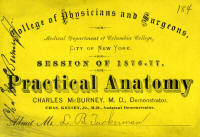Charles McBurney, M.D.
Name: Charles McBurney
Death date: Nov 7, 1913
Place of death: Stockbridge, MA
Type of practice: Allopath
Journal of the American Medical Association Citation: 61:1826
In the history of medicine, Charles McBurney's name will ever be associated with the vermiform appendix as the first surgeon to point out a ready means of detecting a diseased appendix by pressure on a particular spot. Charles McBurney (1845-1913) was professor of surgery at the College of Physicians and Surgeons and worked mainly at Roosevelt Hospital in New York. In 1889, he described the point of maximal abdominal tenderness (McBurney's point) to be determined by the pressure of one finger placed one-third of the distance between the anterior iliac spine and the umbilicus. McBurney pioneered early diagnosis and early operative intervention and in 1894 he described the muscle-splitting incision that today bears his name. The incision in the skin is oblique and about 4-inches long. It crosses a line drawn from the anterior iliac spine and is situated such that its upper third lies above that line.
Charles McBurney was born in Roxbury, Massachusetts on February 17, 1845. He was the son of Charles and Rosine Horton McBurney. He was educated in private schools in and about Boston and entered Harvard University in 1862, receiving the degree of A.B. in 1866, and A.M. in 1869.
He earned his M.D. at the College of Physicians and Surgeons in New York City in 1870, interned at Bellevue Hospital in 1871, and went abroad to continue his medical studies in Vienna, Paris, and London. He began his practice upon his return to New York City.
In 1872, McBurney was appointed assistant demonstrator of anatomy in the College of Physicians and Surgeons and filled this position until 1880, when he was elected instructor in operative surgery. From 1889 to 1892, he was professor of surgery; from 1892 to 1897, he was professor of clinical surgery, and later professor emeritus. He continued to attend to private and hospital practice until 1907 when he retired to Stockbridge, Massachusetts. He was visiting surgeon to St. Luke's Hospital from 1875 to 1888, and was the only attending surgeon to Roosevelt Hospital from 1889 to 1901.
Through the gift of William J. Syms, in 1892 McBurney established the first model elaborate private operating pavilion, The Syms Operating Pavilion. This surgical facility, opened in 1892, achieved national and worldwide prominence for its surgical teaching and research. It was here that he introduced the practice of having the entire surgical team wear rubber gloves, shortly after Halsted had recommended this practice at Johns Hopkins.
He was also consulting surgeon to the New York, Presbyterian, St. Mary's, and Orthopedic Hospitals, and to the Hospital for the Ruptured and Crippled. He was an honorary member of the Royal College of Surgeons, the College of Physicians and Surgeons in Philadelphia, the Surgical Society, and other medical organizations.
Among his contributions to surgery are The Indications for Early Laparotomy, The Treatment of Appendicitis, A Contribution to Cerebral Surgery, and Dislocation of the Humerus Complicated by Fracture. He was a contributor to Dennis' System of Surgery and to The International TextBook of Surgery.
Charles McBurney married Margaret Willoughby Weston on October 8, 1874. They had two sons and a daughter. Mrs. McBurney died on June 1, 1909, Brookline, Massachusetts on November 7, 1913 at age 68. His legacy to surgery of the biliary tract was not awarded the recognition that his contributions in appendicitis received, but his early advocacy of sphincterotomy for common duct stone is worthy of remembrance. He reported six successful cases of removal of biliary calculi from the common duct by the duodenal route in 1898. This novel approach anticipated by at least half a century the operation sphincterotomy for common duct stones, now a mainstay of endoscopy practice.
